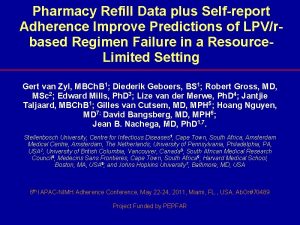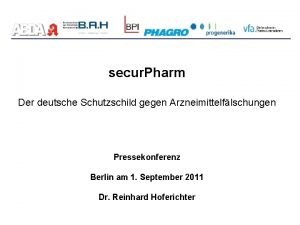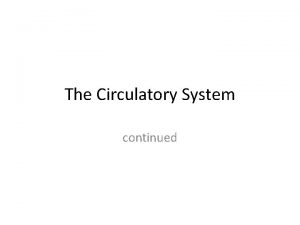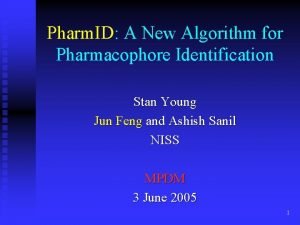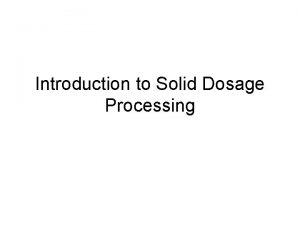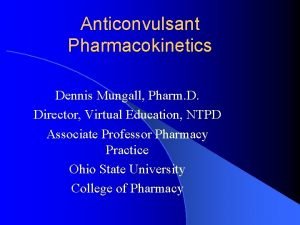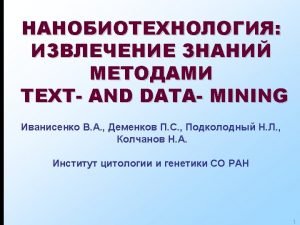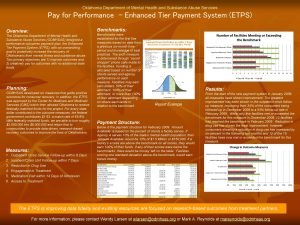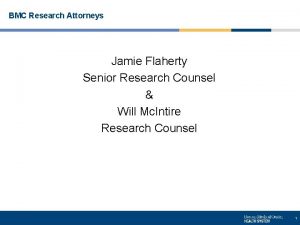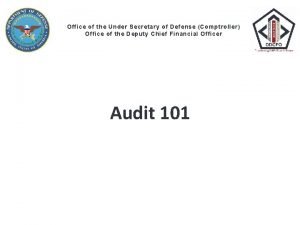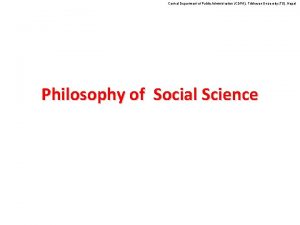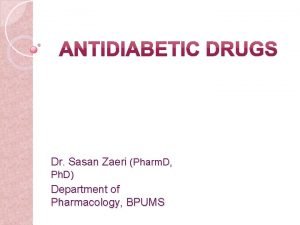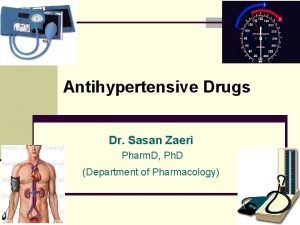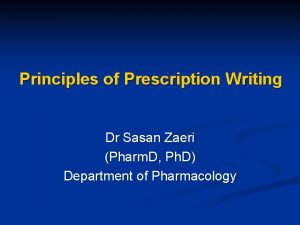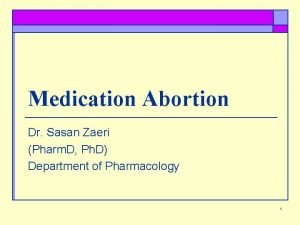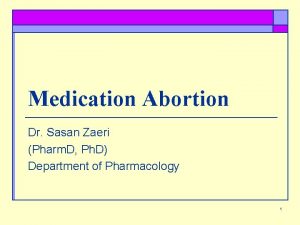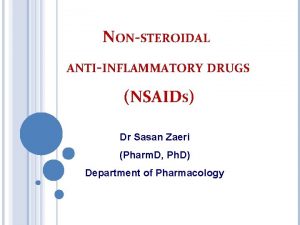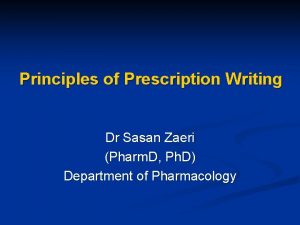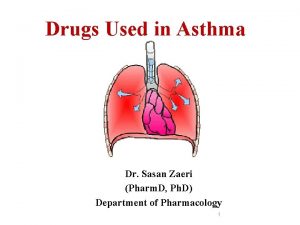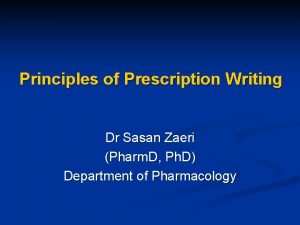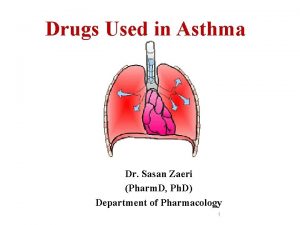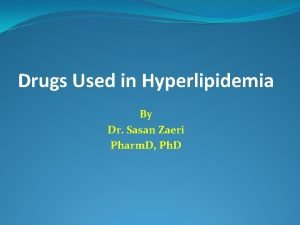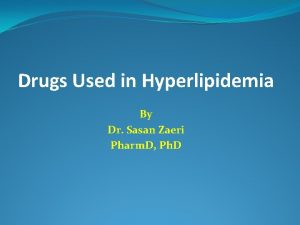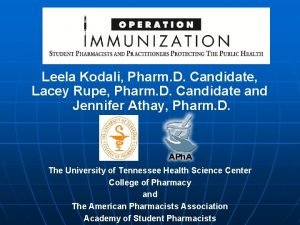Dr Sasan Zaeri Pharm D Ph D Department














































- Slides: 46

Dr. Sasan Zaeri (Pharm. D, Ph. D) Department of Pharmacology, BPUMS

Diabetes mellitus (DM) �The most common metabolic disease �Chronic hyperglycemia Biochemical criteria Normal Prediabetic Diabetic FBS < 100 mg/d. L 100 -125 mg/d. L >126 mg/d. L 2 -h GTT <140 mg/d. L 140 -199 mg/d. L >200 mg/d. L Hb A 1 C <5. 6% 5. 7 -6. 4% >6. 5% 2

Classification � DM Ø Ø An autoimmune disease Onset during childhood Destruction of β-cells Treatment with insulin � DM Ø Ø Ø type II A progressive disorder Onset in adulthood Insulin resistance + progressive destruction of β-cells Early stages controlled with noninsulin antidiabetic drugs Later stages often require addition of insulin to drug regimen 3

Antihyperglycemic Agents Class Available Agents Insulin Sulfonylurea Several forms Glibenclamide (glyburide), Gliclazide, Chlorpropamide Biguanide Thiazolidinedione Metformin Pioglitazone α-Glucosidase inhibitors Acarbose

Antihyperglycemic Mechanisms Augment Insulin Enhance Insulin Delay Supply Action Carbohydrate Absorption Insulins Biguanides α-Glucosidase inhibitors Sulfonylureas Thiazolidinedione s 5

Insulin �A small peptide hormone produced in the pancreas � Synthesis as prohormone proinsulin (86 aa) � Cleavage to insulin (51 aa) & C-peptide � Proinsulin & C-peptide have no physiologic actions 6

Insulin biological effects � Liver: �↑ Storage of glucose as glycogen � ↓ Protein catabolism � Skeletal muscle: �↑ Glucose transport into muscle cells � ↑ Glycogen synthesis and protein synthesis � Adipose tissue: �↑ Glucose transport into fat cells � ↑ TG storage � ↓ Intracellular lipolysis 7

Insulin indications �DM II �DM emergencies �Diabetic pregnant women 8

Insulin Preparations �Different ◦ ◦ capacity to lower blood glucose. Rapid acting Short acting Intermediate acting Long acting 9

Extent and duration of action of various types of insulin 10

Rapid-acting insulin �Lispro, aspart, glulisine �Onset: <15 min �Duration: 3 -4 h �rapid onsets and early peaks of activity 11

Rapid-acting insulin �Lispro, aspart, glulisine �Indications: ◦ control of postprandial glucose (immediately before a meal ) ◦ emergency treatment of uncomplicated diabetic ketoacidosis 12

Short-acting insulin �Regular �Onset: 0. 5 -1 h �Duration: 4 -6 h 13

Short-acting insulin �Regular �Indications: ◦ emergencies of hyperglycemia (IV) ◦ ordinary maintenance regimens (SC) �alone or mixed with intermediate preparations 14

Intermediate-acting insulin �Lente, Neutral Protamine Hagedorn (NPH) �Onset: 1 -4 h �Duration : 10 -16 h 15

Intermediate-acting insulin �NPH insulin: exhibits a delayed onset and peak of action �NPH insulin is often combined with regular and rapid-acting insulins 16

INSULIN TACTICS Once daily NPH injection 17 6 -23

INSULIN TACTICS Twice-daily Split NPH injection Insulin Effect NPH B L S HS B=breakfast; L=lunch; S=supper; HS=bedtime B 18 6 -23

INSULIN TACTICS Twice-daily Split-mixed Regimens Insulin Effect Regular NPH B L S HS B 19 6 -23

INSULIN TACTICS Multiple Daily Injections (MDI) NPH + Regular NPH at AM and HS + Regular AC NPH at HS + Regular AC Regular NPH Insulin Effect Regular NPH B L S HS B 20 6 -24

Long-acting insulin �Glargine, Detemir, Ultralente �Gradual release pattern from injection site �Onset: 4 h �Duration: 12 -24 h 21

Long-acting insulin �Glargine, Detemir, Ultralente �Effects: �provide a peakless basal insulin level lasting more than 20 h �Indication: �control basal glucose levels without producing hypoglycemia 22

Glargine vs NPH Insulin 23 6 -34

Glargine insulin + Lispro insulin Lispro 24

Insulin side effects � Hypoglycemia � Insulin induced immunologic complication � Injection � Weight pain Gain 25

26

Oral antidiabetic drugs �Insulin secretagogues (sulfonylureas) �Biguanide (metformin) �Thiazolidinediones (pioglitazone) �α-glucosidase inhibitors (acarbose) �Most commonly for TM II treatment 27

Major actions of oral antidiabetic drugs 28

29

Sulfonylureas (SUs) �Insulin secretagogues �MOA: ◦ Blockade of ATP-dependent K+ channels (KATP) in β-cells of pancreas→membrane depolarization → ↑release of insulin �Effects: ◦ ↑ Basal and postprandial insulin secretion ◦ No effect in patients with non-functional pancreatic β cells 30

SUs 31

SUs � 1 st generation: � Tolbutamide, Chlorpropamide � 2 nd generation: � Glibenclamide (Glyburide), Glipizide, Glimepiride ◦ More potent ◦ Use more commonly than the older agents 32

SUs �Indication: �Dosing: �Side DM II Once or twice daily effects: ◦ Hypoglycemia ◦ Weight gain 33

34

Biguanides �Metformin �MOA: ◦ ◦ ↓hepatic glucose release ↓gluconeogenesis Enhance peripheral glucose uptake & utilization ↑peripheral tissue sensitivity to insulin �Effects: Enhancement of insulin action, decrease weight �Depends upon: Presence of insulin �Metformin is a euglycemic agent �Slower action 35

Metformin �Indications: ◦ DM II �Dosing: �Side Two to three times daily effects: � Nausea � ↓appetite & weight loss ◦ Lactic acidosis ◦ diarrhea 36

37

α-glucosidase inhibitors �MOA: ◦ Carbohydrate analogs → α-glucosidase inhibition within the intestine → ↓glucose liberation → ↓intestinal glucose absorption → ↓(mild) blood glucose �Acarbose & Miglitol 38

α-glucosidase inhibitors �Effects: ◦ Delays carbohydrate absorption ◦ ↓Postprandial hyperglycemia ◦ No effect on fasting blood sugar and insulin release 39

α-glucosidase inhibitors indications �DM II �Prevent DM II in prediabetics �Must be taken just before a meal �Can be combined with other oral hypoglycemic agents �Dosing: Three times daily (with each meal) 40

α-glucosidase inhibitors side effects �Flatulence � Diarrhea � Abdominal pain 41

42

Thiazolidinediones (glitazones) � Pioglitazone, Rosiglitazone 43

Pioglitazone � MOA: � stimulation of nuclear receptors important for insulin action � � peroxisome proliferator-activated receptor-gamma nuclear receptor (PPAR-γ receptor) ↑target tissue sensitivity to insulin � skeletal muscle and adipose tissues � Effects: ↑glucose uptake in muscle and adipose tissue � ↓both fasting and postprandial hyperglycemia � Inhibition of hepatic gluconeogenesis (↓hepatic glucose output) � Change in lipid metabolism and the distribution of body fat � � Shift of TG from non-adipose tissues to adipose tissue (↓serum TG) 44

Pioglitazone �Indications: ◦ DM II ◦ ↓ risk of DM II in high-risk patients �Dosing: �Side Once daily effects: ◦ Fluid retention �presents as mild anemia and edema ◦ ↑ risk of MI (Rosiglitazone) 45

Any question? 46
 بیمارستان مدرس
بیمارستان مدرس Pharm
Pharm Pharm406
Pharm406 Secur pharm
Secur pharm Library.med.utah.edu/kw/pharm/hyper heart.html
Library.med.utah.edu/kw/pharm/hyper heart.html Hpc exf
Hpc exf Bc bio-pharm
Bc bio-pharm Noel pharm
Noel pharm Outfield pharm
Outfield pharm Pharm id
Pharm id Friciton
Friciton Pharm link
Pharm link Forensic pharmacist
Forensic pharmacist Letazol
Letazol Ambio pharm
Ambio pharm Pharm gkb
Pharm gkb Library.med.utah.edu/kw/pharm/hyper heart.html
Library.med.utah.edu/kw/pharm/hyper heart.html Yolo county planning department
Yolo county planning department Department of measurement standards
Department of measurement standards Fresno county probation
Fresno county probation Pengertian tax amnesty
Pengertian tax amnesty Pefht
Pefht Oklahoma department of mental health
Oklahoma department of mental health Finance departments
Finance departments Department of public works and roads rustenburg
Department of public works and roads rustenburg Kuwait fire department online
Kuwait fire department online Haverford biology
Haverford biology Penn state university meteorology
Penn state university meteorology Bmc legal department
Bmc legal department Oklahoma alternative placement program
Oklahoma alternative placement program California department of general services
California department of general services Ambulatory care whittington
Ambulatory care whittington University of sargodha engineering department
University of sargodha engineering department Waterloo applied math
Waterloo applied math Multi floor plant layout evaluation was developed
Multi floor plant layout evaluation was developed Transport department
Transport department Department vs division
Department vs division Procurement department mission statement
Procurement department mission statement Stanford computer science department
Stanford computer science department Department of defense comptroller
Department of defense comptroller Department of treasury
Department of treasury San luis obispo planning department
San luis obispo planning department Cdpa tu
Cdpa tu San mateo police department jobs
San mateo police department jobs Wilmington planning department
Wilmington planning department Hotel goals examples
Hotel goals examples Wufar dpi
Wufar dpi

